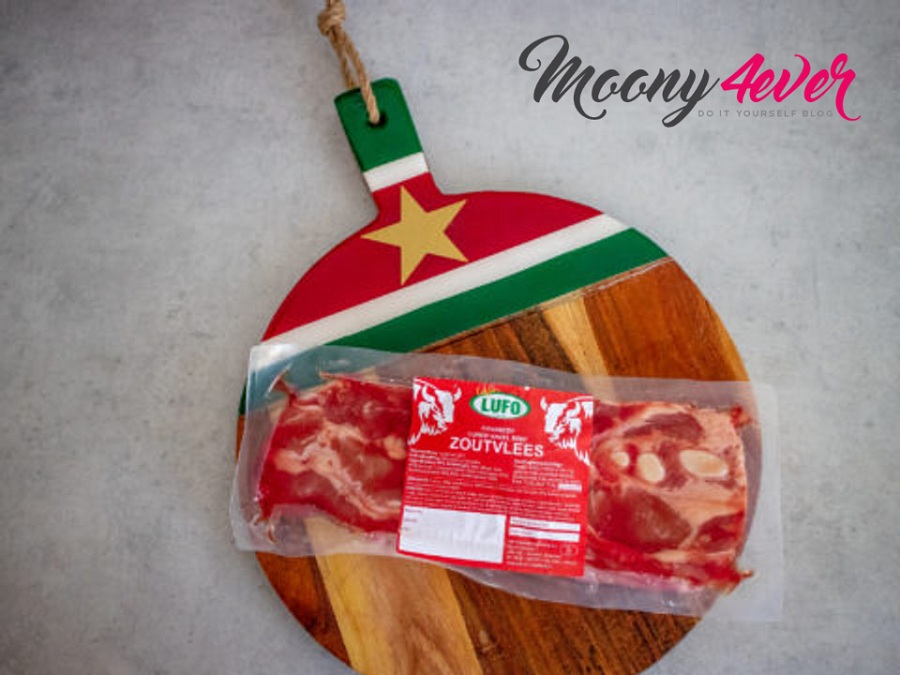Surinamese food is almost unthinkable without salt meat. On the food blog Moony4ever.blog she describe why it is unthinkable and her taste buds will certainly be dissatisfied.
How did salt meat originate?
Through the galley of the sailing ships that then sailed the oceans between Europe, Africa and America. It was when refrigeration did not yet exist and beef had to be preserved throughout the long crossings. Since then, cured beef (supplemented with salt and spices) has made its way, first because of the price and later because of its typical taste, from the galley of the ship’s cook, to the fridge and freezer of my kitchen.
In addition to the renowned oven recipe pom, salt meat is also used to fill sandwiches, to use in soups and to give vegetable dishes more flavor and quality (a boost).
The use of salt meat has long been no longer limited to the heyday in Surinamese cuisine. But a little History about Salt Meat is always good to know. Because of its typical taste, salt meat has now become the basis of most Surinamese cuisines.
The Surinamese Kitchen With Salt Meat
In terms of soups, you can think of cassava soup, grit ‘banana soup and peanut soup.
In terms of vegetables, in addition to pointed cabbage and string beans, especially tropical vegetables such as garter, Surinam vegetables such as: boulanger, sopropo, Antroewa and of course our Brown Beans with Rice (BBR)
While you add (bone-in) bone-in salted meat to the soup at some point, you should do a little more for your vegetables.
The base is formed by first frying onions and garlic, then adding boiled chopped salt meat to it. Then add the pieces of tomato and the vegetables concerned. Then you add some water and let it simmer for about 10 minutes to fifteen minutes on a lower heat. Surinamese often add a pepper and maggie cube or salt while stewing their vegetables.
If you want to keep the vegetables extra crispy, add no or as little water as possible and scoop the whole over high heat regularly.
The salted and boned salted meat is used in famous Surinam soups, such as okra soup, gritiban (banana) soup and, for example, peanut soup; but the salt meat also finds its way as toppings and vegetables such as long beans, tayer leaf, boulanger and e.g. sopropo. Usually the cook adds pepper, salt and black pepper, but he / she can also suffice with the magic medium, which is called aroma block (compressed herbs / flavor enhancer). In short, the use of salt meat gives various Surinamese dishes an extra cachet. By the way, if you fry the vegetables on high heat, you add little water, but if you let it simmer on a little lower heat, you add more water. In any case, don’t let your food boil dry. Stick with it and squeak smoothly to make sure the food doesn’t waste.
Salt meat is also a must in Surinamese Brown Beans with Rice (BB with R) and white beans, preferably with pieces of bone.
You should not try to prepare the Chinese vegetables, such as the many “STIs” (bok choy, kaisoi and, for example, amsoi) with salt meat. Surinamese finish those vegetables with garlic, ginger and possibly some oyster sauce. You can add salt and pepper to taste.
Today, the salt meat is made from all kinds of lean and fatty beef. Inlaid with salt, allspice granules and cloves. However, salt meat should actually be made from the pointed breast of a bull. The real salt meat must be somewhat streaked and you can recognize it by the white cartilage that runs through it.
But why make it difficult while it is easy, I go to the toko in Amsterdam and buy my favorite brand, Lufo Zoutvlees. Usually more expensive than the rest, but that’s because LUFO’s salt meat is surrounded by numerous quality marks and certifications. Well, quality has its price! The salt meat comes in buckets, but is now also vacuum packed, which improves hygiene and visibility in advance. At least you do not buy a cat in a bag, because one wants to have his salt meat sister and the other like that.
